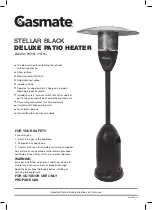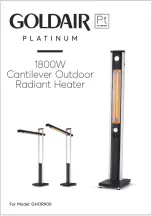
48
www.hotwater .com
100304526_2000545240 _Rev. 01
PERIODIC MAINTENANCE
GENERAL UPKEEP
Make it a habit to look around the heater, the vent piping,
and the hot and cold water pipes. Do not allow any material
to be piled up against the heater. Do not place any object
on top of the vent pipes.
Every 3 - 6 months or as necessary:
•
Clean lint from blower, top of heater.
Once per year:
•
Inspect the Vent System.
•
Burner Operation and Inspection.
•
Combustion Chamber for scaling or sooting.
•
Temperature-Pressure Relief Valve Test.
•
Anode Rod Inspection.
•
Flush a pail of water from the heater drain valve, once
per year.
If any deficiencies or abnormalities are encountered during
these inspections call a qualified service technician.
Flood damage to a water heater may not be readily visible
or immediately detectable. However, over a period of time
a flooded water heater will create dangerous conditions
which can cause death, serious bodily injury, or property
damage. Contact a qualified installer or service agency to
replace a flooded water heater. Do not attempt to repair
the unit! It must be replaced!
VENTING SYSTEM INSPECTION
Breathing carbon monoxide can cause brain damage or death.
Always read and understand instruction manual.
•
Flue gases may escape if vent pipe is not properly
connected.
•
Be alert for obstructed, sooted or deteriorated vent
system to avoid serious injury or death.
•
Do not store corrosive chemicals in vicinity of water
heater.
•
Chemical corrosion of flue and vent system can
cause serious injury or death.
•
Analyze the entire vent system to make sure that
condensate will not become trapped in a section of
vent pipe and therefore reduce the open cross
sectional area of the vent.
Breathing Hazard - Carbon Monoxide Gas
WARNING
At least once a year a visual inspection should be made
of the venting system. You should look for:
•
Obstructions which could cause improper venting. The
combustion, dilution and ventilation air flow must not
be obstructed.
•
Damage or deterioration which could cause improper
venting or leakage of combustion products.
Be sure the vent piping is properly connected to prevent
escape of dangerous flue gases which could cause deadly
asphyxiation.
Obstructions and deteriorated vent systems may present
serious health risk or asphyxiation.
Chemical vapor corrosion of the flue and vent system
may occur if air for combustion contains certain chemical
vapors. Spray can propellants, cleaning solvents,
refrigerator and air conditioner refrigerants, swimming pool
chemicals, calcium and sodium chloride, waxes, bleach
and process chemicals are typical compounds which are
potentially corrosive.
If after inspection of the vent system you found sooting or
deterioration, something is wrong. Call the local gas utility
to correct the problem and clean or replace the flue and
venting before resuming operation of the water heater.
BURNER OPERATION AND INSPECTION
At least once a year a visual inspection should be made of
the main burner and the hot surface igniter assembly for
proper flame characteristics and ignition sequences. This
can be done by removing the outer door and viewing the
main burner operation through the viewport on the inner
door (see Figure 52). The main burner should provide
complete combustion of gas, ignite rapidly, give reasonably
quiet operation, and cause no excessive flame lifting from
the burner ports. If the proper flame characteristics are
not evident (see Figure 53), make sure that the flow of
combustion and ventilation air is not blocked. Inspection
of exhaust/air intake termination is needed to ensure there
is no blockage there.
You should also check for sooting. Soot is not normal and
will impair proper combustion. A visual inspection of the
main burner and hot surface igniter should also be done
at least once a year (see Figure 52).
Soot build-up indicates a problem that requires correction
before further use. Turn “OFF” gas to water heater by
unplugging the power cord and leave off until repairs are
made. Failure to correct the cause of the sooting can result
in a fire causing death, serious injury, or property damage.
VIEWPORT
MAIN
BURNER
IGNITER
AND FLAME
ROD
IGNITER
AND
FLAME
ROD
Figure 52.













































